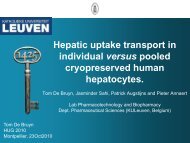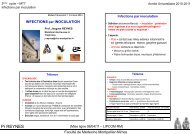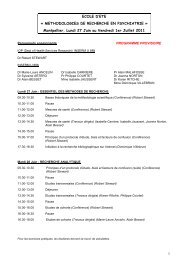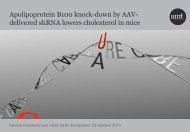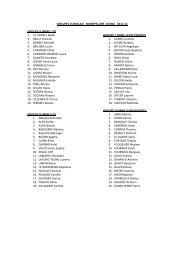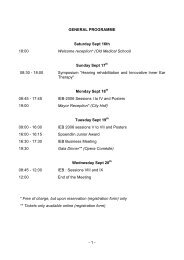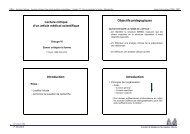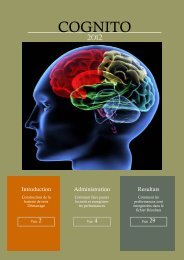Slide presentation - Inserm
Slide presentation - Inserm
Slide presentation - Inserm
Create successful ePaper yourself
Turn your PDF publications into a flip-book with our unique Google optimized e-Paper software.
<strong>Inserm</strong>Institut nationalde la santé et de la recherche médicalemLes régulations rcroisées dans la cellule:impact de traitements médicamenteuxmsur la physiopathologie hépatique h(et(autre)Jean-Marc Pascussi, Amélie Moreau, Agnès Robert, Sabine Gerbal-Chaloin,Cédric Duret, Martine Daujat-Chavanieu, Marie-José Vilarem, Patrick MaurelHepatic Physiopathology<strong>Inserm</strong> U632, Montpellier Francehttp://www.hepatologyinvitro.org/Divisions Thérapeutiques ServierCourbevoie 19 Septembre 2008
INSERM U632 / UM-I EA3768:HEPATIC PHYSIOPATHOLOGYhttp://www.hepatologyinvitro.org/MCHUAdministratorF Couderc AISecretaryN BourgalPRIMARY CULTURESOF HEPATOCYTESL Pichard-Garcia IE, , E Raulet TRM Daujat CR1, P Maurel DR1JM Fabre PUPHBIOTHERAPY RESEARCHINSTITUTESTEM CELLSHepatocyte differentiationStem cells and CancerM Daujat CR1,S Gerbal-Chaloin CR1,C Duret IE, E Raulet TR,N Funakoshi (Int Med),A Herrero (Int Med), P Maurel DR1,P Blanc PUPH, F Navarro PUPHDETOXICATIONNuclear receptor cross-talkMJ Vilarem DR2,JM Pascussi CR1,A Robert TCS, A Moreau (PhD stud)C Breuker (PhD Stud),E Delepine (post-doc),P Maurel DR1, D Larrey PUPHHCV INFECTIONReceptors, effect of cytokinesDiagnosis studiesP Maurel DR1,C Fournier-Wirth (CR EFS),L Pichard-Garcia IE,C Gondeau (post-doc), P Briolotti TRJ Coste (DR EFS), D Larrey PUPH,G Pageaux MCUPHEFSConventionEFS/INSERM
Regulation of gene expressionregulatoryregionResponse elementscodingregionRNA pol IIexon 1 exon 2TATATBPs±1Pre-mRNuclear receptorsTranscription factors+-mRNAAAA• SP-1, C/EBPs, DBP, HNF-1, HNF-3, HNF-4, etc.• AhR, PPARs, PXR, CAR, GR, etc.Combination of specific transcription factorsdefines:• gene expression level• tissue / cellular specificityprotein and activity
Transcription factors, notably nuclear receptors,control a battery of genes (signaling pathways)AgonistTATABPRNA Pol IIgene 1gene 2gene 3NRxgene 4gene x
Examples of signaling pathwaysLow O 2tension1α,25(OH) 2-VitD3HIF-1aVDRHIF-1a/ARNTVDR/RXREPO,VEGF,Other targetgenesTarget genesCYP24, ...BIOLOGICALFUNCTIONSHIF:Hypoxia inducible factorBIOLOGICALFUNCTIONSVDR:Vitamin D receptor
Nuclear receptor mediated gene activationabsence of ligandOtherTFsCoRepPXR RXRHDACchromatin compactingRNA pol IICorepressors:SMRT, NCoRSin3A, TIF-1αLCoR, RIP140,etc.ER-6TATATBPsCYP3A4Low or no genetranscriptionCo-RepOtherTFsCoActHATchromatin openingCoactivators:SRC-1, GRIP-1CBP, PGC-1α,etc.ligandPXR*RXRRXRRNA pol IIER-6TATATBPsCYP3A4High genetranscription
xenobiotic/drugother TFsAhRARNTPXRRXRCARGRGRRXRPPARRXRCYP1,other XMTSCYP2A, 2B, 2C, 3A,other XMTSCYP4,other XMTSxenobiotic/drug metabolism and elimination
Nuclear receptor PXR (NR1I2)NA/B C D E FDNAligandRXR PXRxenobioticCTissue expressionLiver, GI tract, kidneyLigandsAntibiotics (rifampicin,etc.)Barbiturates (phenobarbital)Glucocorticoids, RU486, PCNAntifongals (clotrimazole)Proton pump inhibitors (Benzimidazoles)Calcium channel blockers (nifedipine)Bile acids, Guggulsterones,Vitamin E, PCBs (antagonists in man)Hyperforin, others …NRE: AGGTCA-likenDRnTarget genes:CYPs: CYP2B6, CYP2C8/9/19, CYP3A4-7 ...Phase II: UGT, GST, ST ...Transporters: MDR1, MRP2-4, SLC21A6, ...ALAS-1, apoA1, HDL-C, others ...nnERnIRnnatural ligand?
Activation of PXRFrom Negishi et al.in rodent hepatocytePCN2PXRCCRPPXRHSPligand1?RXRPXRPXR-RE(ER6)cofactorsCYP3Aand othertarget genescytosolnucleus
Nuclear receptor CAR (NR1I3)NA/B C D E FDNARXRCARNRE: AGGTCA-likeligandxenobioticxenobioticCTissue expressionLiver, GI tract, kidneyLigands/activatorsConstitutively activeAndrostanol (inverse agonist)Clotrimazole (inverse agonist)Bile acids (transrepressors)Barbiturates (non ligands)Phenytoin, CITCO,Bilirubin, farnesol, others ...Target genes:CYPs: CYP2B6, CYP2C8/9/19, CYP3A4-7 ...Phase II: UGT, GST, ST ...Transporters: MDR1, MRP2-4, SLC21A6, ...ALAS-1, apoA1, HDL-C, others ...nnnDRnERnIRnnatural ligand/activator?
Nuclear translocation of CAR: a critical stepOAPP2AP?CaMK/AMPKLKB1/AMPK(Marc 2000; Honkakoski 2002)(Rencurel 2005; Rencurel 2006;Blatter 2007)PB?PB2?CARCCRPHSPP?CAR?KN62RXRCARcofactorsCYP2B6TCPOBOP1CARCCRPCARCAR-RE(DR4)and othertarget genesHSPcytosolnucleusFrom Negishi et al.
oxidative stressinfectioninflammationLe métabolisme des xénobiotiques est affectépar de nombreux stimuli physiopathologiquesPPARdiseaseshypoxiaAhRotherTFshormonesxenobioticstoxicitymetabolismpregnancyPXRenvironmentalpollutantsdevelopmentCARGRagebile acidssexand others ...dietfastingelimination
Les xénobiotiques affectent l'homéostasie de nombreuxendobiotiques et/ou leurs fonctionsavec pour conséquences des réactions toxiquesHormonesSteroids, glucocorticoidsthyroids, etc.ReproductionCell proliferationapoptosisneolipogenesisVitaminsRetinoids, vit D,etc.xenobioticsGluconeogenesisFA oxidationbonemineralisationBile acids and cholesterolhomeostasisketogenesisglycolysisand others ...
Comment les voies de signalisation activées parles xénobiotiques interfèrent-elles, ou sont-ellesaffectées, par d'autres voies de signalisation?Rôle des drégulations croisées (crosstalks)entre récepteurs nucléaireset autres facteurs transcriptionnels
Signaling pathwaysLigands X iLigands Y iNR XNR Ytarget genes X jtarget genes Y jbiological functionsbiological functions
nuclear receptor crosstalkLigands X iLigands Y iNR Xligand sharingNR YExamples:• CAR and PXR• PXR and GR• FXR and PXR• FXR and VDR• LXR and PXR• PPAR and PXRspecies specificitytarget genes X jtarget genes Y jPascussi et al. Ann Rev Pharmacol Toxicol 2007
nuclear receptor crosstalkLigands X iLigands Y iExamples:• PXR-VDR(CYP24)• PXR/CAR-TR (Spot14)• PXR/CAR-VDR(CYPs, SULT)• PXR/CAR-FXR(CYPs, SULT)• CAR-HNF4 (CYP7A1)• PXR-PPARγ (CD36)NR XNR Yspecies specificityresponse elementsharingtarget genes X jtarget genes Y jPascussi et al. Ann Rev Pharmacol Toxicol 2008
nuclear receptor crosstalkLigands X iLigands Y iExamples:• GR-CAR/PXR• FXR-PXR• PXR-PPARγspecies specificityNR XNRx regulatesNRyexpressionNR YCascadeGRtarget genes X jtarget genes Y jPXR CAR RXRPPARαPascussi et al. Ann Rev Pharmacol Toxicol 2008
nuclear receptor crosstalkLigands X iLigands Y iExamples:• AhR-ER• CAR/PXR-FoxO1• SHP-CAR/PXR• PXR-FoxA2NR XNRxcoreceptorof NRyNR Yspecies specificitytarget genes X jtarget genes Y jPascussi et al. Ann Rev Pharmacol Toxicol 2008
nuclear receptor cross-talkLigands X iLigands Y iExamples:• CAR/PXR-T3/T4 (TR)• PXR-1,25-OH D3 (VDR)• CAR/PXR-AhRNR Xligand Y iproduced/metabolisedby gene X jNR Yspecies specificity?Gerbal-Chaloin et al. Cell Signal 2005target genes X jtarget genes Y jPascussi et al. Ann Rev Pharmacol Toxicol 2008
Preparation of human hepatocytesfrom liver lobectomies1st surgical resection2nd resectionSurgery departmentnetwork:• Montpellier/Nîmes• Lyon• Toulouse• BordeauxHepatocytepreparationL2 laboratoryPerfusionisolation andculture
Phenotypic characterisation of human hepatocytesin long-term culture systemLydiane PichardJean-Bernard FerriniPichard et al. Drug Metab Dispos 1990Daujat et al. Methods Enzymol 1991Blanc et al. Gastroenterology 1992Maurice et al FASEB J 1992Pichard et al. Mol Pharmacol 1992Blanc et al. Hepatology 1995Muntane-Relat et al. Hepatology 1995Blanc et al. J Hepatol 1996Maurel Adv Drug Del Reviews 1996Ferrini et al. Chem-Biol Int 1997Ferrini et al. Meth Mol Biol 1998Ferrini et al. J Hepatol 2001Pichard-Garcia et al. Methods Enzymol 2002Biron-Andreani et al. Brit J Haematol 2004Pichard et al. Meth Mol Biol 2006Pascussi et al. Hepatology 2007
Induction of CYP proteins in human hepatocytesCYP1A2T0UTRIFTCDDPBCocktUTRIFTCDDPBCocktUTRIFD9 D16 D30TCDDPBCocktStd 1A2CYP2B6Std 2B6T0UTRIFTCDDPBCocktUTRIFTCDDPBUTRIFD9 D16 D30CocktTCDDPBCocktCYP2C9/19Std 2C9Std 2C19T0UTRIFTCDDPBCocktUTRIFTCDDPBCocktUTRIFD9 D16 D30TCDDPBCocktCYP3A4Std 3A4T0UTRIFTCDDPBCocktUTRIFPichard-Garcia et al. Methods in Enzymology 2002Cockt: RIF+PB+TCDDTCDDPBCocktUTRIFD9 D16 D30TCDDPBCockt(D: days in culture)
infectionThe metabolism of xenobiotics is affected by manyphysiopathological stimulioxidative stressinflammationPPARdiseases1980sGlucocorticoids affectthe detoxication function:mechanism???hypoxiaAhRotherTFshormonesxenobioticstoxicitymetabolismeliminationpregnancyPXRenvironmentalpollutantsdevelopmentCARGRagebile acidssexdietfasting
CYP gene regulation and glucocorticoids: the case of CYP2C9CYP2C9 is a target of GR, CAR and PXRSabine Gerbal-CPXR CAR GRCAR/PXR-RE GRE CYP2C9Gerbal-Chaloin et al. J Biol Chem 2002
Induction of CYP proteins in human hepatocytesCYP1A2T0UTRIFTCDDPBCocktUTRIFTCDDPBCocktUTRIFD9 D16 D30TCDDPBCocktStd 1A2CYP2B6Std 2B6T0UTRIFTCDDPBCocktUTRIFTCDDPBUTRIFD9 D16 D30CocktTCDDPBCocktCYP2C9/19Std 2C9Std 2C19T0UTRIFTCDDPBCocktUTRIFTCDDPBCocktUTRIFD9 D16 D30TCDDPBCocktCYP3A4Std 3A4T0UTRIFTCDDPBCocktUTRIFPichard-Garcia et al. Methods in Enzymology 2002Cockt: RIF+PB+TCDDTCDDPBCocktUTRIFD9 D16 D30TCDDPBCockt(D: days in culture)
Jean-Marc PascussiSabine Gerbal-ChaloinThe impact of GC on xenobiotic metabolismhas been known for many years ....PXR and CAR are inducibleby glucocorticoidsRPA hPXR/CARNPDPRUPCNDEXPREDCORTRIFUTPXRCAR is a direct GR targetCARMWOH-CPreddex100dex10RIFRUPBUTPascussi et al. Mol Pharmacol 2000aPascussi et al. Mol Pharmacol 2000bPascussi et al. Mol Endocrinol 2003
The GR-PXR/CAR-CYP cascadeand physiopathological stimuliGene “X, Y, Z” ZSTIMULUSEric AssénatZdenek DvorakCédric Duret• Cytokines, , (Il-1*, Il-6, TNF, etc.)• Chemicals (colchicine****,, ketoconazole***)• Others ….?glucocorticoidsGRGR* Assénat et al. Hepatology 2004** Dvorak et al. Mol Pharmacol 2003*** Duret et al. Mol Pharmacol 2006CARRXRPXRRXRCYP2B, CYP2C, CYP3A,others XMTS genes ….CYP2C9,others*Gerbal-Chaloin et al. JBC 2002CYP2B, CYP2C, CYP3A,other XMTS genes ….xenobiotic metabolism & disposition
Xenobiotics affect the homeostasis of manyendobiotics and related functionsHormonesSteroids, glucocorticoidsthyroids, etc.ReproductionCell proliferationapoptosisneolipogenesisVitaminsRetinoids, vit D,etc.xenobioticsGluconeogenesisFA oxidationbonemineralisation1970sSome drugs provokeosteomalacia upon long termtreatment: mechanism???Bile acids and cholesterolhomeostasisketogenesisglycolysis
Vitamin D signaling pathwayand biological functionsVitD* 2R1, 3A4, 2J3CYP27A*25 (OH) VitDCYP27B1,25(OH) vitD2• Ca and PO 4 homeostasis• bone mineralisation - resorption• paraTH synthesis• immunomodulationVDR(NR1I1)• tissue regeneration• apoptosisTarget genesbiologicalfunctions• cell differentiation
The PXR/CAR-VDR crosstalkMarie-Jo VilaremVDR/RXR binds to and transactivates PXR andCAR-responsive elements in CYP2/3 and other genesLionel DrocourtL Drocourt et al. J Biol Chem 2002QUESTION:Do PXR and CAR activate VDRtarget genes?
1,25(OH) vitD2CYP24(two VDREs)VDR/RXRCYP24 mRNA is inducibleby PXR agonistsin primary human hepatocytes1,24,25(OH) vitD3(inactive)Jean-Marc Pascussifold induction503010**CYP24 mRNA******CYP3A4 mRNA*******UTVitDRIFHPCARBPBUTVitDRIFHPCARBPBPXR agonistsPXR agonistsJM Pascussi et al. J Clin Invest 2005
CAR/RXR binds to and transactivatesthe two VDR-responsive elements of CYP24HEK293 cells co-transf with pCYP24pVDRE-LUC + pCARAmélie MoreauRXR+-VDRCARPXRhisPXR-VDRCARPXRhisPXRLUC10007500EMSA assay* **** * * *60045002001500CYP24VDRE1VDRE2UTAnolVDRE-1 wtVDRE-1 mutpGl30UTAnolVDRE-2 wtVDRE-2 mutAnol: antrostanolMoreau et al. BBRC 2007
CAR and PXR activators/agonists induceCYP24 mRNA in primary human hepatocytes(CAR)(CAR/PXR)(PXR)(PXR)Moreau et al. BBRC 2007
Xu et al. Mol Pharmacol 2006These authors suggested that osteomalacia results from the fact thatCYP3A4 is capable of hydroxylating vit D in position 24,as CYP24, although much less efficiently.1,25(OH) vitD2CYP3A4CYP241,24,25(OH) vitD3
PXR-VDR (double?) crosstalkConsequence: xenobiotic-induced osteomalaciaxenobiotics1,25(OH) vitD2CYPs, UGTs,SULTs, MDRs, etc.PXR/RXRCAR/RXRVDR/RXRbonemineralisation,other functions1,25(OH) vitD2CYP3A4Xu et al.Mol Pharmacol 2006CYP241,24,25(OH) vitD3VDREVDREJM Pascussi et al. J Clin Invest 2005Moreau et al. BBRC 2007barbituratesphenytoinrifampicinothers ...decreased level of vitDosteomalaciaVit D blood levelbone demineralisationosteomalacia
Xenobiotics affect the homeostasis of manyendobiotics and related functionsHormonesSteroids, glucocorticoidsthyroids, etc.ReproductionCell proliferationapoptosisneolipogenesisVitaminsRetinoids, vit D,etc.xenobioticsGluconeogenesisFA oxidationbonemineralisation1970sSome drugs provokelipid disorders upon long termtreatment: mechanism???Bile acids and cholesterolhomeostasisketogenesisglycolysis
Jean-Marc PascussiAmélie Moreau
Spot14 and lipid metabolismS14 is a small (17kDa) acidic (pI(4.65) protein with no sequence similarity to other functionalmotifs. . MID1IP1 is a paralog expressed in liver.S14 is expressed in lipogenic tissues and is postulated to play a key role in thyroid hormonestimulation of hepatic de novo lipogenesis.S14 is a target of TR and LXR.S14 transcription is required for TH-stimulated transcription of lipogenic genes such as FASand ACLY, and triacylglycerol formation.Confirmation by antisens RNA strategy and S14-KOmice.S14 overexpression in MCF-7 cells increases intracellular TG content and Nile red staining.S14 present in nucleus of hepatocytes, forms homodimers and physically interacts with TRKinlaw et.al. JBC 1995; Campbell et.al. Endoc 2003; Zhu, et.al. Endoc 2001 and 2005;LaFave et.al. Endoc 2006; Chou et.al. BBRC 2007
Spot14 is a PXR target genein primary human hepatocytes3025FT285 mRNA fold induction2015105CTRLRif 0.3Rif 3Rif 30SR12813PAXT09T3PXRLXRLXR, PXRTRActinCYP3A4CYP2B6S14Moreau et al. to be publishedin collaboration with Technologie Servier
Effect of PXR-siRNA on CYP3A4 and S14 expressionin primary human hepatocytesmRNA fold induction18161412108642CYP3A47654321nsns*****CTRLsiNCsiPXR-193siPXR-460siPXR-858CTRLsiNCsiPXR-193siPXR-460siPXR-858CTRLsiNCsiPXR-193siPXR-460siPXR-858CTRLsiNCsiPXR-193siPXR-460siPXR-858nsns****S14RIF (5µM)RIF (5µM)Moreau et al. to be publishedin collaboration with Technologie Servier
Moreau et al. to be publishedin collaboration with Technologie Servier
PXR-RXR complex specifically binds toand transactivates the human S14 TRE-4194-2909-2660-1824-1318-683-326S14DR2ER6TREDR4DR2DR2DR4RXRCARPXRT3RCAR+RXRPXR+RXRT3R+RXRRXRCARPXRT3RCAR+RXRPXR+RXRT3R+RXRRXRCARPXRT3RCAR+RXRPXR+RXRT3R+RXR* * * * * *NR1 CYP2B6 TRE-S14 DR4 -1824 S14Moreau et al. to be publishedin collaboration with Technologie Servier
PXR-RXR complex specifically binds toand transactivates the human S14 TREhS14 TRE:CACAGGGTGAGGGTGACTTCAGGTCATCTACTCTAChS14 ΔTRE:CACAGTTTGAGTTTGACTTCATTTCATCTACTCTACΔTRES145x10x5xTRES1410xpER63A45x10xLUC activity2.521.5p=0.02p=0.0051n.s.0.5pSG5PXRpSG5PXRpSG5PXRpER6 CYP3A4NR1x3Moreau et al. to be published2B6in collaboration with Technologie ServierTREx2S14ΔTREx2S14
Lipogenesis is controlled by severaltranscription factors and nuclear receptorsTR/RXRT3Spot14lipogenic enzymesfeeding(insulin)LXRChREBPGlut4, G6PDH,ACS, ACC1,FAS, MTTP,HCS, ACLYLipogenesis(insulin)SREBP-1c(glucose)ACC1, L-PKFAS, SCD-1PKA(glucagon)PPARγ(overexpression)CD36, , ACS,FABP, SCD-1fasting(glucagon)Pawar et.al. JBC 2003; Schadinger et.al. AJPEM 2005; Zhou et.al. JBC 2006;Joseph et.al. JBC 2002; Laffitte et.al. PNAS 2003; Koo et.al. JBC 2000; Dentin et.al. JBC 2004;
Expression of lipogenic genes in human hepatocytesin response to rifampicinSREBP1cChREBPCD36SRB1PPARγ1PPARγ2mean +/- S.D.1.2 ±1.40.83 ±0.250.8 ±0.31.22 ±0.660.79 ±0.330.69 ±0.41n IF>1.5 / n3/100/121/151/121/130/12range0.68-1.520.43-1.220.31-1.730.05-0.320.51-1.530.29-1.47p valuensnsnsnsnsnsCYP3A4S14actinFASACLYPKmean +/- S.D.84 ±82 ***7.8 ±5 ***0.9 ±0.91.98 ±0.2 ***1.51 ±0.59 *0.98 ±0.92n IF>1.5 / n15/1617/190/1914/187/162/14range1.1-2781.1-21.60.62-1.400.47-3.090.29-2.760.28-3.94p valuep
PXR activation increases free fatty acidcontent in human hepatocytesMyristic acid - C14:0Stearic acid - C18:0Palmitic acid - C16:025020015010050****180014001000600200***900700500300100**CTRL RIF CTRL RIFCTRL RIF CTRL RIFCTRL RIF CTRL RIFFT280FT281FT280FT281FT280FT281Oleic acid - C18:1n9Palmitoleic acid - C16:1n7Gamma linolenic acid - C18:3n6300200100******40302010***654321*****CTRL RIF CTRL RIFFT280FT281CTRL RIF CTRL RIFFT280 FT281Moreau et al. to be publishedin collaboration with Technologie ServierCTRL RIF CTRL RIFFT280FT281
PXR-TR crosstalkConsequence: xenobiotic-induced lipogenesisxenobioticsPXR/RXRCAR/RXRTR/RXRT3LXR(insulin)PKA(glucagon)ChREBPSREBP-1c(glucose)PPARγTRESpot14(overexpression)Spot14lipogenic enzymesGlut4, G6PDH,ACS, ACC1,FAS, MTTP,HCS, ACLYACC1, L-PKFAS, SCD-1CD36, , ACS,FABP, SCD-1Moreau et al. to be publishedin collaboration with Technologie Servierunderlined: : lipogenic enzymesfound to be inducedby PXR/CAR agonists(in this work)xenobioticsfeeding(insulin)Lipogenesisfasting(glucagon)
Xenobiotic-cellular energy pathway crosstalksxenobioticsFoxO1insulinPGC-1αPEPCK, G6PIGFBP, TATApoCIII, etc.GluconeogenesisCARPXRFoxA2Spot14CPT1, HMGCS,3-BDH, UCP2,GCK, L-PK, etc.β-oxidationketogenesisglycolysisCYP3A4UGT, STOATP, MRPmousePPARγSREBP-1cCD36, , ACS,FABP, SCD-1ACC1, L-PKFAS, SCD-1LipogenesisXenobiotic detoxicationChREBPGlut4, G6PDH,ACS, ACC1,FAS, MTTP,HCS, ACLYactivationinhibitionrodent versus human ?1. Kodama 2004. 2. Nakamura 2007. 3. Moreau 2007; Zhou 2006. 4. Zhou 2006
Xenosensor crosstalk with other signaling pathways(rodent versus human ?)Zhou et al.Assénat et al.Pascussi et al.Gradin et al.Chan et al.Safe et al.Ohtake et al.Pascussi et al.Moreau et al.Kodama et al.Zhou et al.Nakamura et al.Rencurel et al.Blater etal.Kodama et al.LI et al.Shiraki et al.Miao et al.Seol et al.Ourlin et al.Qatanani et al.Moreau et al.Handschin et al.Gnerre et al.Roth et al.pleiotropic responses to drugseffect of physiopathological stimulion drug metabolismPascussi et al. Drug Metab Rev 2003; Biochim Biophys Acta 2003;Xenobiotica 2004; Hand Book Exp Pharmacol 2004; Ann Rev Pharmacol Toxicol 2008;Assénat et al. Eur J Cancer 2006; Moreau et al. Mol Pharmaceutics 2007
Conclusion• On sait depuis longtemps que certains médicaments exercent leurs effets (cyto/géno) toxiquesvia la formation d'intermédiaires réactifs qui se lient covalemment aux protéines ouaux acides nucléiques• On sait également que les médicaments agonistes ou activateurs des xénorécepteursAhR, PXR ou CAR peuvent être responsables d'interactions médicamenteuses ou dela majoration de la formation d'intermédiaires réactifs (effet inducteur enzymatique)• Les régulations croisées entre les xénorécepteurs et d'autres voies de signalisationpermettent d'expliquer de nouvelles variantes des effets toxiques de ces médicaments(perturbations endocriniennes, peturbations lipidiques, stéatoses non alcoolique,perturbation de l'homéostasie osseuse, etc.)• Il est possible que dans certains cas ces régulations croisées conduisent à des effetspharmacologiques bénéfiques (ex: régulation négative de la néoglucogénèse)
Remerciements• Technologie Servier (B Walther, Y Parmentier, T Umbdenstock)• Sanofi-Aventis (G Fabre, V Abalea)• CEE (6 th PCRDT; Projets Predictomics et Steroltalk)• ANR• UA Meyer and V Tamasi• M Beylot• Chirurgiens: JM Fabre, A Sa-Cunha, F Navarro, B Suc




